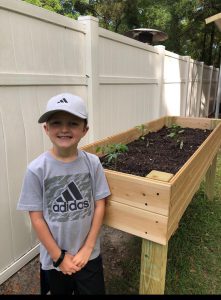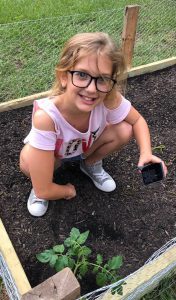When trying to find the perfect outdoor activity for children, consider container gardening. There are many benefits to kids gardening from the educational to the physical benefits. But one of the best things is your kids will love it! It takes little effort to persuade kids to dig in the soil and get dirty. Unfortunately, most families may not be able to prepare a traditional garden weather it be the lack of equipment or community restrictions. A great alternative is container gardens. Container gardens can be easy to create, maintain and very fruitful.
Container Gardening: What You Will Need
When starting a container garden with your kids, there are a few basic items you will need. These include containers ranging from 3-5 gallons in size, soil, plant fertilizer, water and of course some seeds or plants. Some vegetable plants are more suitable for containers than others. Tomatoes, eggplants, and pepper plants are good choices for container gardening.
Steps for Best Results
Step 1. Choose your container. The type of vegetable plant being grown in the container will need to be considered when choosing a container. A 5-gallon bucket, old ice chest or large pot may be needed for tomato plants. These plants can easily grow 3-5 feet tall quickly and will need to be staked. Not only will the large pot provided adequate space for roots, but it will also provide a sturdy base to which will ultimately hold the  staked-up plant. Eggplants and pepper plant will grow somewhat slower and can be shaped more tree like making it much easier to stake. This may allow you to choose a smaller pot of 3 or4 gallon size.
staked-up plant. Eggplants and pepper plant will grow somewhat slower and can be shaped more tree like making it much easier to stake. This may allow you to choose a smaller pot of 3 or4 gallon size.
Step 2. Provide drainage. Regardless of what type of container is chosen, it must allow for drainage to prevent over watering and rotting. The easiest way is to use a drill. 4 to 5 holes that are about ½ inch in diameter should be adequate.
Step 3. Choose a soil. The better the soil being used in the container, the better the results will be of the container garden. Most potting soils sold at local garden centers are sufficient. If potting soils are not available, use composted material and rich soil from areas where organic matter has decomposed such as leaves and mulch.
Step 4. Set your vegetable plant. After filling the container with soil approximately 2 inches from the top of the container, add the vegetable plant. Prepare a whole that is about twice the size of the root-ball. If the plant you have chosen appears root bound, that meaning the root system has conformed to the shape of the container it was started in, gently scratch the roots with the fingers so root tips are loosened some and able to grow more freely. If planting seeds, following the directions provided on the packet.
 Step 5 Place plant in sunlight and water daily. Most vegetable plant will need at least 4-5 hours of full sun per day. This will cause the soil to dry quickly and the plants will need to be watered daily. A liquid fertilizer can be applied through water in a dry time released fertilize appropriate for container plants can be applied as directed.
Step 5 Place plant in sunlight and water daily. Most vegetable plant will need at least 4-5 hours of full sun per day. This will cause the soil to dry quickly and the plants will need to be watered daily. A liquid fertilizer can be applied through water in a dry time released fertilize appropriate for container plants can be applied as directed.
Project Complete: Enjoy Your Garden!
Now that the container garden is finished, children can have the joy of being responsible for the container garden. Plants will let their caregiver know when there is a need, which is most likely going to be daily watering.
While giving advice is helpful, parents should avoid the temptation of over correcting their child’s gardening mistakes or taking control. Let this be the child’s project. Gardening is a great for kids to learn the practice of trial and error.
If you would like more information about container gardening, please contact your local Extension Office.
 0
0
